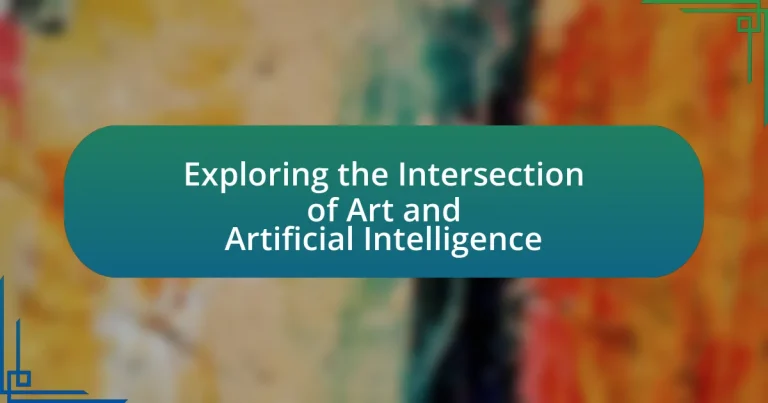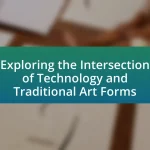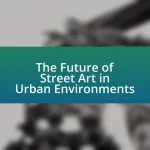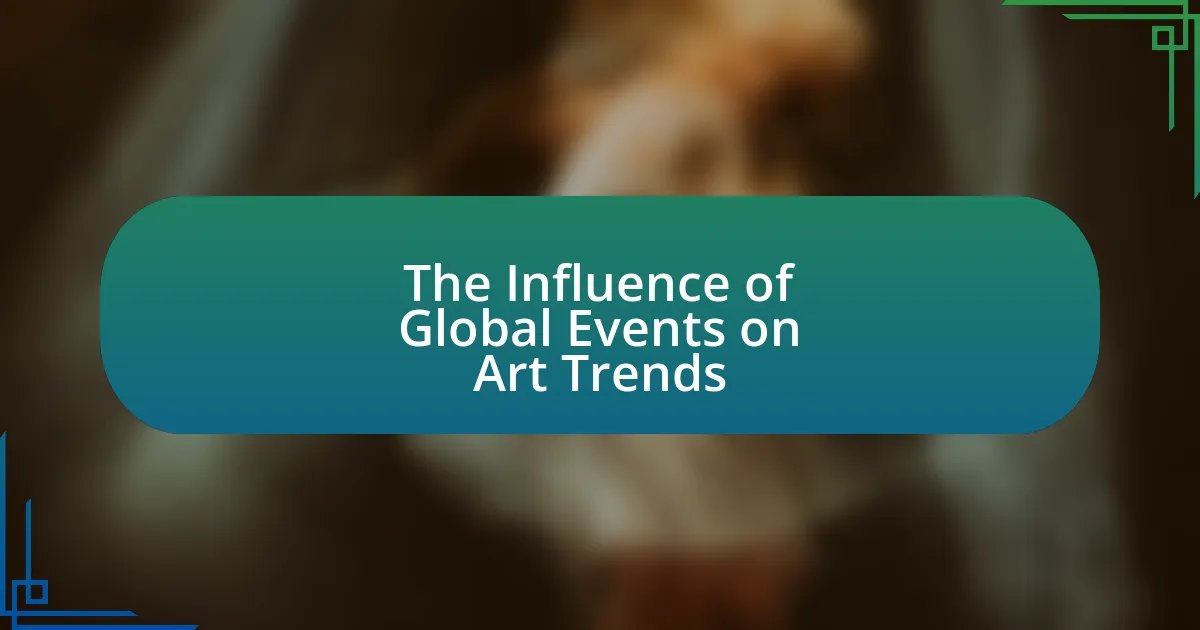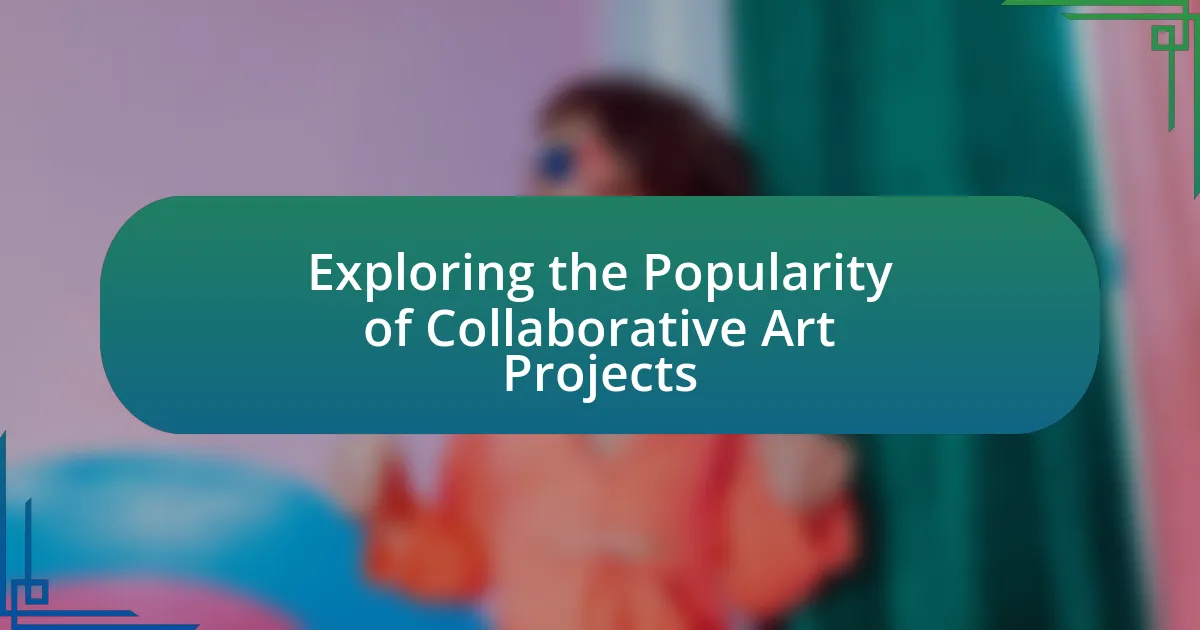The article explores the intersection of art and artificial intelligence, highlighting how AI technologies are utilized to create, enhance, and analyze artistic works. It discusses the influence of AI on artistic expression, including the use of generative adversarial networks, neural style transfer, and natural language processing in various forms of art. The article also addresses the ethical implications surrounding authorship, originality, and bias in AI-generated art, while examining the cultural shifts and future trends in the art world due to AI integration. Additionally, it provides practical tips for artists on how to experiment with AI tools and resources available for learning about this evolving field.

What is the Intersection of Art and Artificial Intelligence?
The intersection of art and artificial intelligence involves the use of AI technologies to create, enhance, and analyze artistic works. AI algorithms can generate visual art, compose music, and even write poetry, demonstrating the capability of machines to mimic human creativity. For instance, projects like DeepArt and OpenAI’s DALL-E utilize neural networks to produce original artworks based on user inputs, showcasing how AI can serve as a collaborative tool for artists. Additionally, AI can analyze existing artworks to identify patterns and styles, providing insights that can influence future creations. This fusion of technology and creativity is reshaping the landscape of artistic expression and challenging traditional notions of authorship and creativity.
How has Artificial Intelligence influenced the field of Art?
Artificial Intelligence has significantly influenced the field of Art by enabling new forms of creativity and artistic expression. AI technologies, such as machine learning algorithms and neural networks, allow artists to generate unique artworks, automate repetitive tasks, and enhance their creative processes. For instance, AI-generated artworks, like those created by the algorithm AICAN, have been exhibited in galleries and sold at auctions, demonstrating the commercial viability and acceptance of AI in the art world. Additionally, AI tools like DeepArt and Runway ML empower artists to experiment with styles and techniques that were previously inaccessible, thus expanding the boundaries of traditional art forms. This integration of AI not only challenges the definition of authorship in art but also raises questions about the role of human creativity in the artistic process.
What are the key technologies in AI that impact artistic creation?
Key technologies in AI that impact artistic creation include generative adversarial networks (GANs), neural style transfer, and natural language processing (NLP). GANs enable the creation of new images by training two neural networks against each other, resulting in high-quality artwork, as demonstrated by projects like DeepArt and Artbreeder. Neural style transfer allows artists to apply the style of one image to the content of another, facilitating innovative artistic expressions, evidenced by applications such as Prisma. NLP technologies enhance artistic creation by enabling the generation of text-based art and interactive storytelling, as seen in AI-driven platforms like OpenAI’s GPT models. These technologies collectively transform the artistic landscape by providing new tools and methods for creativity.
How do artists integrate AI into their creative processes?
Artists integrate AI into their creative processes by utilizing machine learning algorithms and generative models to enhance their artistic expression and streamline workflows. For instance, artists employ tools like DeepArt and DALL-E to generate unique visual content or manipulate existing images, allowing for innovative combinations of styles and concepts. Research indicates that AI can assist in creating music, with platforms like AIVA composing original scores based on user-defined parameters. This integration not only expands the creative possibilities but also fosters collaboration between human intuition and machine efficiency, as evidenced by projects like “The Next Rembrandt,” which used AI to create a new painting in the style of Rembrandt.
Why is the intersection of Art and AI significant?
The intersection of Art and AI is significant because it transforms creative processes and expands the boundaries of artistic expression. AI technologies, such as machine learning and neural networks, enable artists to generate new forms of art, automate repetitive tasks, and explore innovative styles that were previously unattainable. For instance, AI-generated artworks have gained recognition in major art markets, with pieces like “Edmond de Belamy” selling for $432,500 at auction, illustrating the commercial viability and cultural impact of AI in the art world. This convergence not only challenges traditional notions of authorship and creativity but also fosters collaboration between human artists and machines, leading to a redefinition of what art can be.
What cultural shifts are occurring due to AI in the art world?
AI is driving significant cultural shifts in the art world by redefining creativity, authorship, and accessibility. Artists are increasingly collaborating with AI technologies to generate new forms of art, leading to a broader understanding of what constitutes creativity. This collaboration challenges traditional notions of authorship, as works created with AI raise questions about the role of the artist versus the machine. Furthermore, AI tools democratize art creation, allowing individuals without formal training to produce art, thus expanding participation in the art community. For instance, platforms like DALL-E and Midjourney enable users to create visual art through simple text prompts, illustrating how AI is reshaping artistic expression and engagement.
How does AI challenge traditional notions of creativity?
AI challenges traditional notions of creativity by introducing algorithms that can generate original works, thereby blurring the lines between human and machine creativity. Traditional creativity is often viewed as a uniquely human trait, rooted in emotional depth and personal experience; however, AI systems, such as generative adversarial networks (GANs), can produce art, music, and literature that mimic human styles and even innovate beyond established norms. For instance, the AI program AICAN has been shown to create paintings that critics have difficulty distinguishing from those made by human artists, demonstrating that AI can not only replicate but also contribute to creative processes. This shift raises questions about authorship, originality, and the very definition of creativity itself, as AI-generated works challenge the exclusivity of human artistic expression.
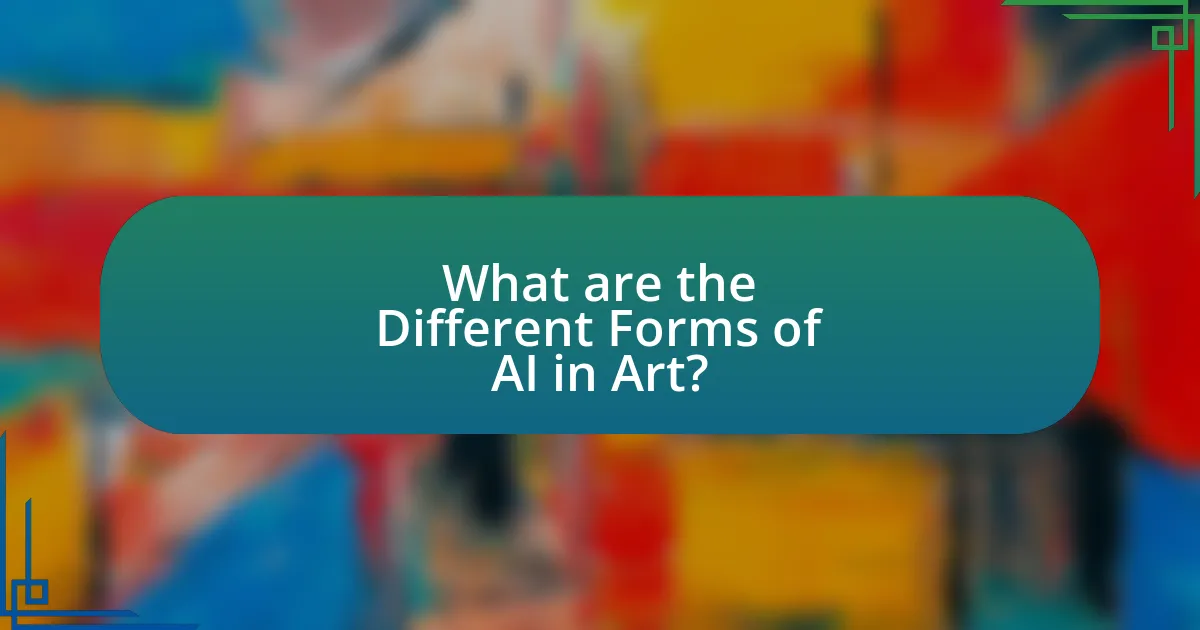
What are the Different Forms of AI in Art?
Different forms of AI in art include generative art, style transfer, and AI-assisted design. Generative art utilizes algorithms to create unique artworks, often based on specific parameters or datasets, exemplified by projects like “The Next Rembrandt,” which generated a new painting in the style of Rembrandt using machine learning. Style transfer involves applying the visual appearance of one image to the content of another, allowing artists to blend styles, as seen in applications like DeepArt. AI-assisted design tools, such as Adobe’s Sensei, enhance the creative process by automating repetitive tasks and providing intelligent suggestions, thereby streamlining workflows for artists. These forms illustrate the diverse ways AI is transforming artistic expression and creation.
What types of AI-generated art exist?
AI-generated art exists in several forms, including generative art, style transfer, deepfake art, and algorithmic art. Generative art utilizes algorithms to create unique visual pieces, often based on random inputs or predefined rules. Style transfer involves applying the artistic style of one image to the content of another, effectively merging two distinct visual elements. Deepfake art uses AI to manipulate images and videos, creating hyper-realistic representations that can alter appearances or actions. Algorithmic art relies on mathematical functions and computer programming to produce visual works, emphasizing the role of computation in the creative process. Each type showcases the diverse capabilities of AI in transforming traditional artistic practices.
How do generative adversarial networks (GANs) create art?
Generative adversarial networks (GANs) create art by employing a two-part system consisting of a generator and a discriminator. The generator creates images from random noise, while the discriminator evaluates these images against real artworks, providing feedback to the generator. This adversarial process continues until the generator produces images that are indistinguishable from real art, effectively learning artistic styles and features through iterative refinement. Research has shown that GANs can replicate various artistic styles, as demonstrated in projects like DeepArt and Artbreeder, where users can generate unique artworks based on learned patterns from existing art datasets.
What role do neural networks play in artistic expression?
Neural networks serve as powerful tools in artistic expression by enabling the generation of novel artworks and enhancing creative processes. These algorithms analyze vast datasets of existing art to learn patterns, styles, and techniques, allowing them to create original pieces that mimic or innovate upon traditional forms. For instance, systems like DeepArt and DALL-E utilize convolutional neural networks to transform photographs into artworks in the style of famous painters, demonstrating their capability to blend human creativity with machine learning. This intersection of technology and art not only expands the boundaries of artistic expression but also raises questions about authorship and originality in the digital age.
How do artists use AI tools in their work?
Artists use AI tools to enhance creativity, automate processes, and generate new forms of art. By leveraging algorithms and machine learning, artists can create unique visual pieces, music, and interactive installations that would be difficult to achieve manually. For instance, AI programs like DeepArt and DALL-E allow artists to transform photographs into artworks or generate images based on textual descriptions, showcasing the potential of AI in artistic expression. Additionally, AI can analyze vast datasets to inspire new concepts or styles, as seen in projects like “The Next Rembrandt,” which used AI to create a painting in the style of Rembrandt by analyzing his works. This integration of AI not only expands the possibilities of artistic creation but also challenges traditional notions of authorship and creativity in art.
What are some popular AI tools for artists today?
Some popular AI tools for artists today include DALL-E, Midjourney, and Artbreeder. DALL-E, developed by OpenAI, generates images from textual descriptions, allowing artists to visualize concepts quickly. Midjourney is known for its ability to create high-quality, stylized images based on user prompts, making it a favorite among digital artists. Artbreeder enables users to blend images and create unique artworks through collaborative AI, fostering creativity and experimentation. These tools are widely used in the art community for their innovative capabilities and ease of use.
How do these tools enhance or alter the creative process?
These tools enhance the creative process by providing artists with innovative methods for generating ideas and executing their visions. For instance, artificial intelligence algorithms can analyze vast datasets of existing art to inspire new styles or concepts, allowing creators to explore uncharted territories in their work. Additionally, tools like generative design software enable artists to experiment with forms and structures that may not be feasible through traditional methods, thus expanding the boundaries of creativity. Research indicates that artists using AI-assisted tools report increased productivity and a broader range of creative possibilities, demonstrating the significant impact these technologies have on artistic expression.
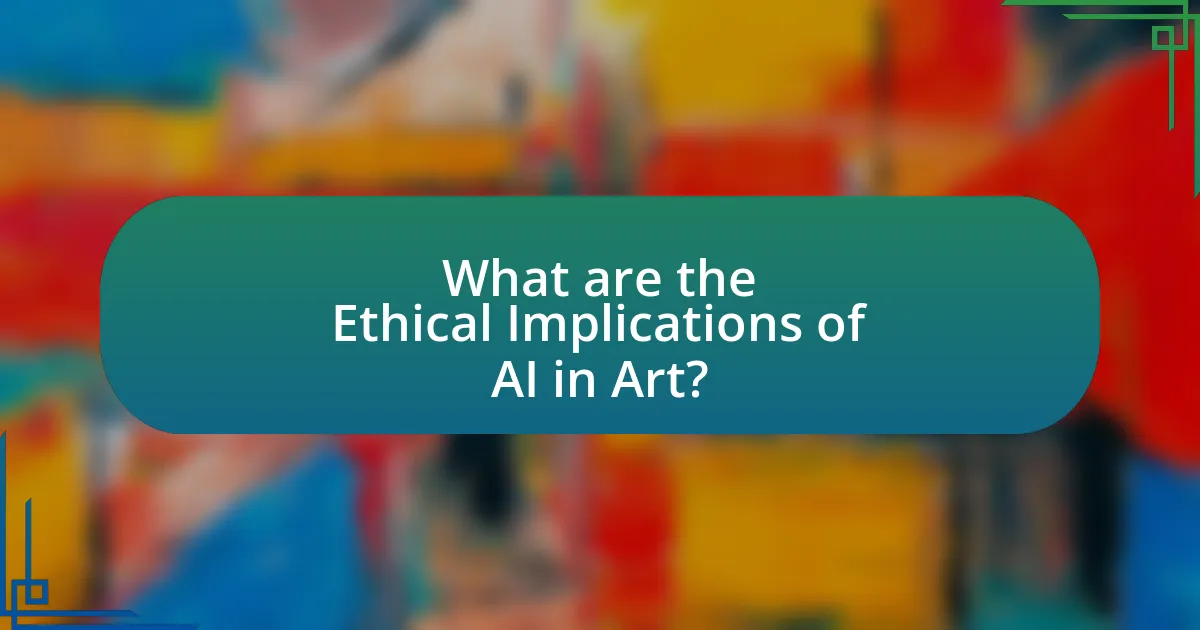
What are the Ethical Implications of AI in Art?
The ethical implications of AI in art include issues of authorship, originality, and the potential for bias in creative outputs. AI-generated art raises questions about who owns the rights to the artwork, as traditional notions of authorship may not apply when a machine creates a piece. Furthermore, the originality of AI art is contested, as algorithms often learn from existing works, leading to concerns about plagiarism and the dilution of human creativity. Additionally, biases present in training data can result in AI producing art that reflects societal stereotypes or excludes diverse perspectives, which raises ethical concerns about representation and inclusivity in the art world.
What ethical concerns arise from AI-generated art?
AI-generated art raises several ethical concerns, primarily related to authorship, copyright, and the potential for bias. The issue of authorship arises because it is often unclear who owns the rights to art created by AI systems, as these systems are trained on existing works without explicit permission from original creators. Copyright concerns stem from the possibility that AI-generated art may infringe on the intellectual property rights of artists whose works were used in the training data, leading to legal disputes. Additionally, bias in AI algorithms can result in the perpetuation of stereotypes or the exclusion of diverse artistic expressions, as these systems may reflect the limitations of their training datasets. These ethical dilemmas highlight the need for clear guidelines and regulations in the realm of AI-generated art to protect both creators and the integrity of artistic expression.
How does copyright law apply to AI-created works?
Copyright law generally does not recognize AI as an author, which complicates the ownership of AI-created works. In many jurisdictions, copyright protection requires a human author, meaning that works generated solely by AI may not qualify for copyright protection. For example, the U.S. Copyright Office has stated that works created without human intervention do not meet the criteria for copyright eligibility. This legal framework raises questions about the rights of developers, users, and the AI itself, as the lack of clear authorship can lead to disputes over ownership and usage rights.
What are the implications for artists’ rights and ownership?
The implications for artists’ rights and ownership in the context of artificial intelligence involve significant challenges regarding copyright and intellectual property. As AI technologies increasingly generate art, questions arise about who holds the rights to these creations—whether it is the artist who provided the input, the developer of the AI, or the AI itself. Current copyright laws, such as the U.S. Copyright Act, stipulate that only human authors can hold copyright, which complicates ownership when AI is involved in the creative process. Additionally, the use of existing artworks to train AI models raises concerns about unauthorized reproduction and derivative works, potentially infringing on the rights of original artists. These complexities necessitate a reevaluation of legal frameworks to protect artists’ rights while fostering innovation in the intersection of art and technology.
How can we ensure responsible use of AI in the art community?
To ensure responsible use of AI in the art community, it is essential to establish clear ethical guidelines and frameworks that govern AI applications in artistic creation. These guidelines should address issues such as copyright, authorship, and the potential for bias in AI-generated content. For instance, the European Commission’s guidelines on AI emphasize the importance of transparency and accountability, which can be applied to art by requiring artists and developers to disclose the AI tools used in their work. Additionally, fostering collaboration between artists, technologists, and ethicists can help create a balanced approach that respects artistic integrity while leveraging AI’s capabilities.
What guidelines should artists follow when using AI?
Artists should follow ethical guidelines, copyright laws, and transparency when using AI in their work. Ethical guidelines include ensuring that AI-generated content does not perpetuate biases or misinformation. Copyright laws require artists to understand the ownership of AI-generated works, as legal frameworks vary by jurisdiction. Transparency involves disclosing the use of AI in the creative process to maintain authenticity and trust with audiences. These guidelines help artists navigate the complexities of integrating AI into their artistic practices responsibly.
How can collaboration between artists and technologists promote ethical practices?
Collaboration between artists and technologists can promote ethical practices by integrating diverse perspectives that prioritize social responsibility and cultural sensitivity. Artists often bring a critical lens to the implications of technology, highlighting potential biases and ethical dilemmas, while technologists contribute technical expertise to implement solutions. For instance, projects like “AI for Good” demonstrate how interdisciplinary teams can create AI systems that are designed with ethical considerations, ensuring that technology serves humanity positively. This collaboration fosters a dialogue that encourages transparency, accountability, and inclusivity, ultimately leading to the development of technologies that respect human rights and promote equitable access.
What are the Future Trends in Art and AI?
Future trends in art and AI include increased collaboration between artists and AI technologies, the rise of generative art, and the integration of AI in art curation and personalization. Artists are increasingly using AI tools to create innovative works, as seen in projects like Refik Anadol’s “Archive Dreaming,” which utilizes machine learning to transform data into visual art. Generative art, where algorithms create unique pieces, is gaining popularity, evidenced by the sale of AI-generated artworks at major auctions, such as Christie’s sale of “Edmond de Belamy” in 2018. Additionally, AI is being employed in art curation, enabling personalized experiences for viewers by analyzing preferences and suggesting artworks, as demonstrated by platforms like Artfinder. These trends indicate a significant shift in how art is created, experienced, and valued in the digital age.
How might AI continue to evolve in the art world?
AI will continue to evolve in the art world by enhancing creativity through advanced algorithms that generate unique artworks and assist artists in their creative processes. For instance, AI systems like OpenAI’s DALL-E and Google’s DeepDream have already demonstrated the ability to create visually compelling images based on textual descriptions, showcasing the potential for AI to serve as a collaborative tool for artists. Furthermore, AI can analyze vast datasets of existing art to identify trends and styles, enabling artists to innovate while remaining connected to historical contexts. This evolution is supported by the increasing integration of machine learning techniques in art education and practice, which allows for personalized learning experiences and the democratization of art creation.
What potential innovations could emerge from this intersection?
Potential innovations that could emerge from the intersection of art and artificial intelligence include generative art algorithms, AI-assisted creative tools, and personalized art experiences. Generative art algorithms utilize machine learning to create unique visual pieces, as demonstrated by projects like DeepDream and DALL-E, which have gained significant attention for their ability to produce novel artistic styles. AI-assisted creative tools, such as Adobe’s Sensei, enhance artists’ workflows by automating repetitive tasks and providing intelligent suggestions, thereby fostering creativity. Personalized art experiences can be developed through AI-driven platforms that analyze user preferences and curate tailored art collections, as seen in applications like Artfinder. These innovations not only expand the possibilities of artistic expression but also democratize access to art creation and appreciation.
What Practical Tips Can Artists Use When Integrating AI?
Artists can effectively integrate AI by utilizing it as a collaborative tool to enhance creativity and streamline workflows. For instance, artists can use AI algorithms to generate new ideas or variations of their work, allowing them to explore concepts they might not have considered. Additionally, artists can leverage AI for tasks such as image editing, color matching, and even creating music, which can save time and allow them to focus on the more nuanced aspects of their art.
Research indicates that artists who adopt AI tools report increased productivity and innovation in their creative processes. A study published in the journal “Leonardo” highlights how artists using AI have expanded their artistic vocabulary and pushed the boundaries of traditional art forms. By embracing AI, artists can not only enhance their own work but also contribute to the evolving dialogue between technology and art.
How can artists start experimenting with AI in their work?
Artists can start experimenting with AI in their work by utilizing AI tools and platforms designed for creative applications, such as generative art software, machine learning algorithms, and AI-assisted design programs. These tools allow artists to create unique visual pieces, music, or interactive installations by leveraging AI’s ability to analyze data and generate new content. For instance, platforms like Runway ML and DALL-E enable artists to generate images based on textual descriptions, while tools like Amper Music assist in composing original music tracks. The integration of AI into artistic processes not only enhances creativity but also opens new avenues for collaboration between human artists and machine intelligence.
What resources are available for learning about AI in art?
Resources for learning about AI in art include online courses, books, academic journals, and workshops. Online platforms like Coursera and edX offer courses specifically focused on AI applications in art, such as “Creative Applications of Deep Learning with TensorFlow” by Kadenze. Books like “Artificial Intelligence and Art: Toward Human-Level AI Agents” by Jon McCormack provide in-depth insights into the subject. Academic journals, including the Journal of Artificial Intelligence and Consciousness, publish research on the intersection of AI and art. Additionally, workshops and conferences, such as SIGGRAPH, facilitate hands-on learning and networking opportunities for artists and technologists.
